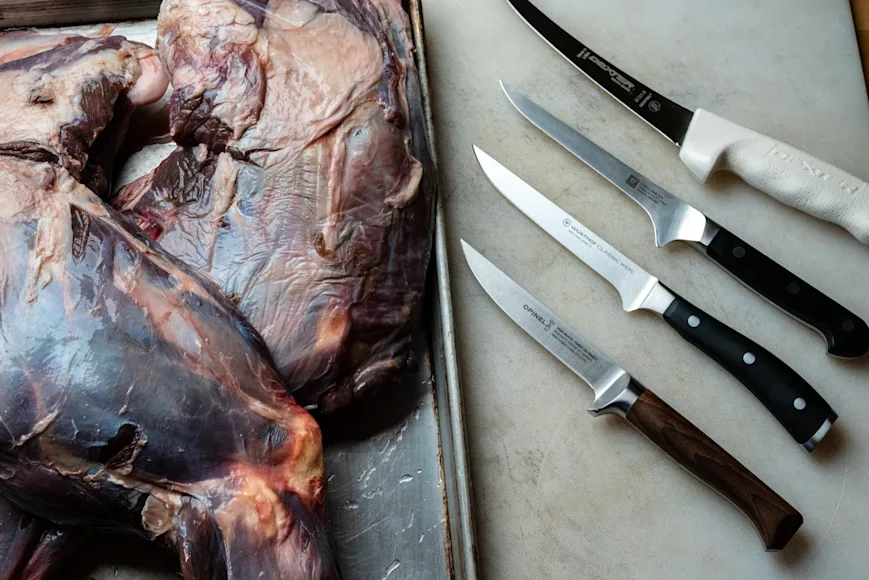We may earn revenue from the products available on this page and participate in affiliate programs. Learn more
Hunters demand the best boning knives for butchering their game. Once the trigger has been pulled or the arrow released, the real work begins of turning that animal into food. Doing that safely and efficiently requires the right tools for the job, and a boning knife is perhaps the most important tool there is.
Similar to a fillet knife, a boning knife is a long, flexible blade perfect for working around bones, following the natural contours of an animal. The best boning knives are sharp enough to cut through flesh, cartilage, and connective tissue with ease while having the flexibility to glide around bones without unnecessary waste or damage to the meat.
Butchering your own game opens the door to countless culinary possibilities, letting you determine the exact cuts you want and minimize waste. It also further connects you to the entire process, which is why we hunt in the first place. While gambrels, saws, skinning knives, and other useful tools make the job easier, none are as important as a proper boning knife.
With countless options on the market, it can be difficult for consumers to know what products to spend their hard-earned money on and trust to fill their freezer. We’ve put a handful of the best boning knives on the market to the test to make that decision easier and more informed. Here are a few of the best boning knives and why they made the cut.
Best Overall: Dexter-Russell 6" Sani-Safe Curved Boning Knife
Best for Butchers: Zwilling Pro 5.5" Flexible Boning Knife
Best for the Money: Wusthof Classic Ikon 5" Boning Knife
Best for Processing Deer: Opinel Forged 1890 5”
Best Overall: Dexter-Russell 6" Sani-Safe Curved Boning Knife
Key Features
Ergonomic Sani-Safe handle
Stainless Dexteel blade
Made in the USA
Pros
Affordable
Dependable
Lightweight
Cons
Curved blade hard to sharpen
Slightly slippery handle
The Dexter S131 6-inch curved boning knife is the best overall boning knife for most people. Dexter-Russell is a well-known cutlery manufacturer with a reputation for hard-working commercial-grade kitchen products. You can find their knives in butcher shops, restaurant kitchens, cafeterias, and just about everywhere else food is made on a large scale. This is not some bespoke hipster knife made for people with clean boots and no blood on their aprons. They are tools built for the high-volume user who routinely has a lot of animals to get through in a hurry. The no-frills design is simple and clean and made to perform over and over again.
I have personally used Dexter knives, including their boning knives for years in professional kitchens, and I have always found them to be extremely dependable. They are also made right here in the USA. Dexter boning knives are offered in a variety of configurations for the preferences of the end-user, allowing you to choose between a straight or curved blade in narrow, wide, stiff, or flexible options. They also come in different handle styles such as hard plastic, wood, and Dexter’s proprietary SOFGRIP. While the entire Dexter line is outstanding, we chose the S131-6 6-inch Sani-Safe curved boning knife for our top pick due to its combination of great features and rugged dependability. It is also extremely lightweight compared to some other high-end full tang boning knives.
I like the curved blade boning knife (S131-6) for more precision cuts using the tip of the blade, or long sweeping cuts to remove silverskin or to run parallel with the bone. The 6-inch blade is the perfect length for working on most big game animals. While the curved model is slightly harder to put an edge on than the straight blade model, both are durable, sharp, and offer great edge retention. Made with proprietary DEXSTEEL, a strain-free high carbon steel, the S131 is extremely sharp, holds its edge, and is easy to touch up and resharpen after abuse. It has just enough bend at the tip for working around bones and laying flat against ribs. I prefer a slightly stiffer blade for working with wild game, but if you want a knife that doubles as a fish fillet knife, you may want to go with the flexible version.
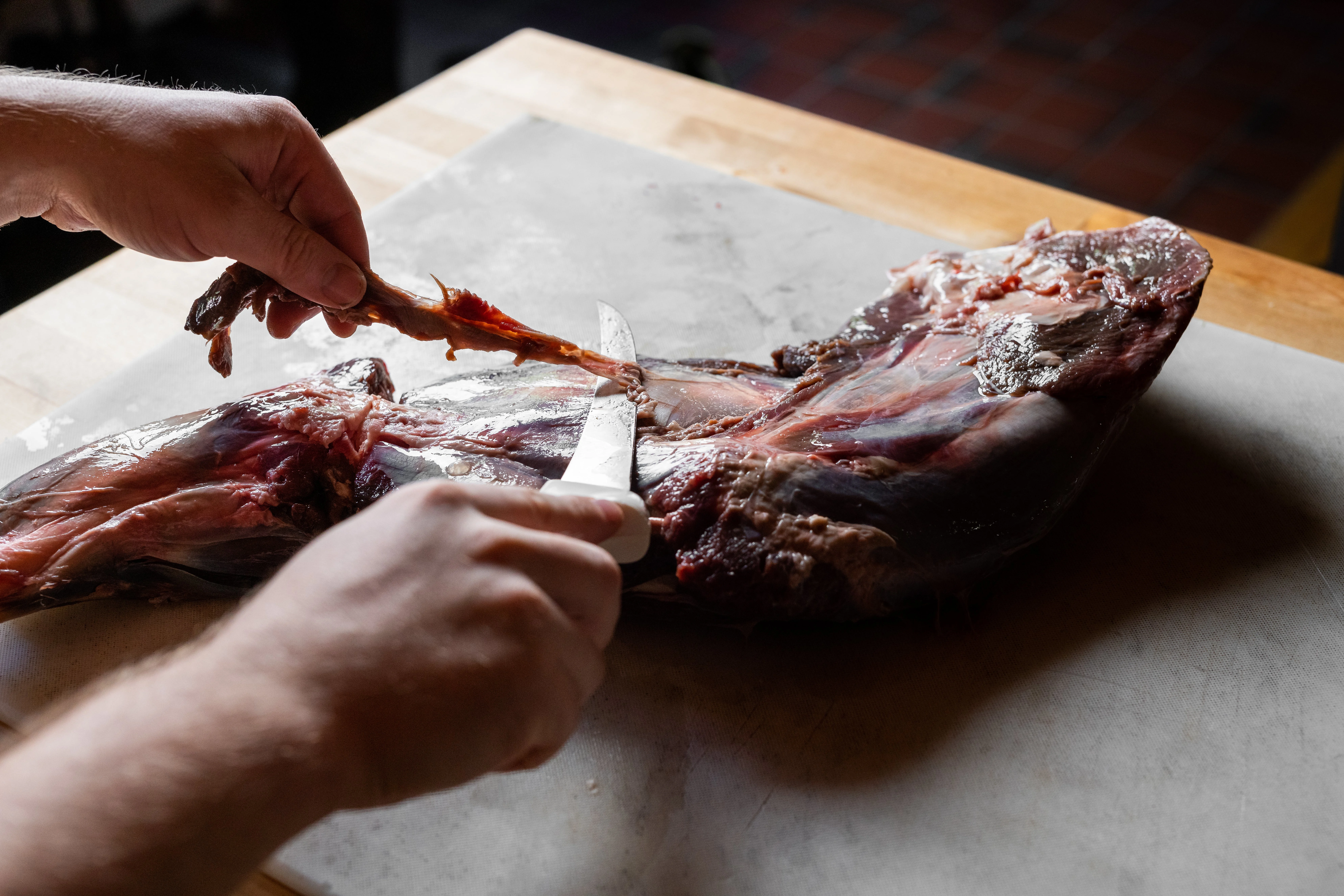
Dexter’s handles are generally very ergonomic and comfortable in the hand. The S131’s handle is contoured for your fingers and provides plenty of protection up front where you’re most likely to slip. The hard plastic handle is a bit slicker than something like a SOFGRIP handle, but it is also much easier to keep clean and wash off than textured sticky rubber. The Sani-Safe hard plastic handle and tight blade-to-handle seal make this knife NSF certified and very safe from a food safety perspective. There are not a lot of nooks and crannies for meat to get caught or for germs to hold onto. Whether you butcher one animal or a hundred in the course of a season, you can count on Dexter’s boning knives to work every time.
Best for Butchers: Zwilling Pro 5.5" Flexible Boning Knife
Key Features
German made
Full tang, single piece of steel
Thin flexible blade
Pros
Flexible
High-quality
Easy to sharpen
Cons
Price
The Zwilling Pro 5.5-inch boning knife is the best flexible boning knife on the market. Zwilling, along with its sister company J.A. Henckels (and others), is a German cutlery manufacturer with a storied legacy and reputation for high-quality knives and kitchen products. Compared to many of its competitors, the Zwilling Pro is significantly more flexible along the length of its blade. This makes it perfect for close-to-the-bone tasks as well as cutting parallel to the meat to remove fat and silverskin. This flexibility also makes it well suited to double as a fillet knife for fish.
One of the Zwilling Pro’s biggest features is its single-piece, full-tang high carbon stainless steel blade. Manufactured in Germany, the blade is a fantastic blend of quality, durability, and edge retention. High-quality steel tends to be extremely hard, making it durable and able to hold an edge, but that can also make it difficult to sharpen. The Zwilling Pro offers the best of both worlds with its ice-hardened FRIODUR high carbon steel blade that comes precision-honed with a laser-controlled edge from the factory. This provides the perfect bevel angle for a razor-sharp edge that stays sharp longer, and while extremely durable, can also be sharpened and touched up with relative ease.
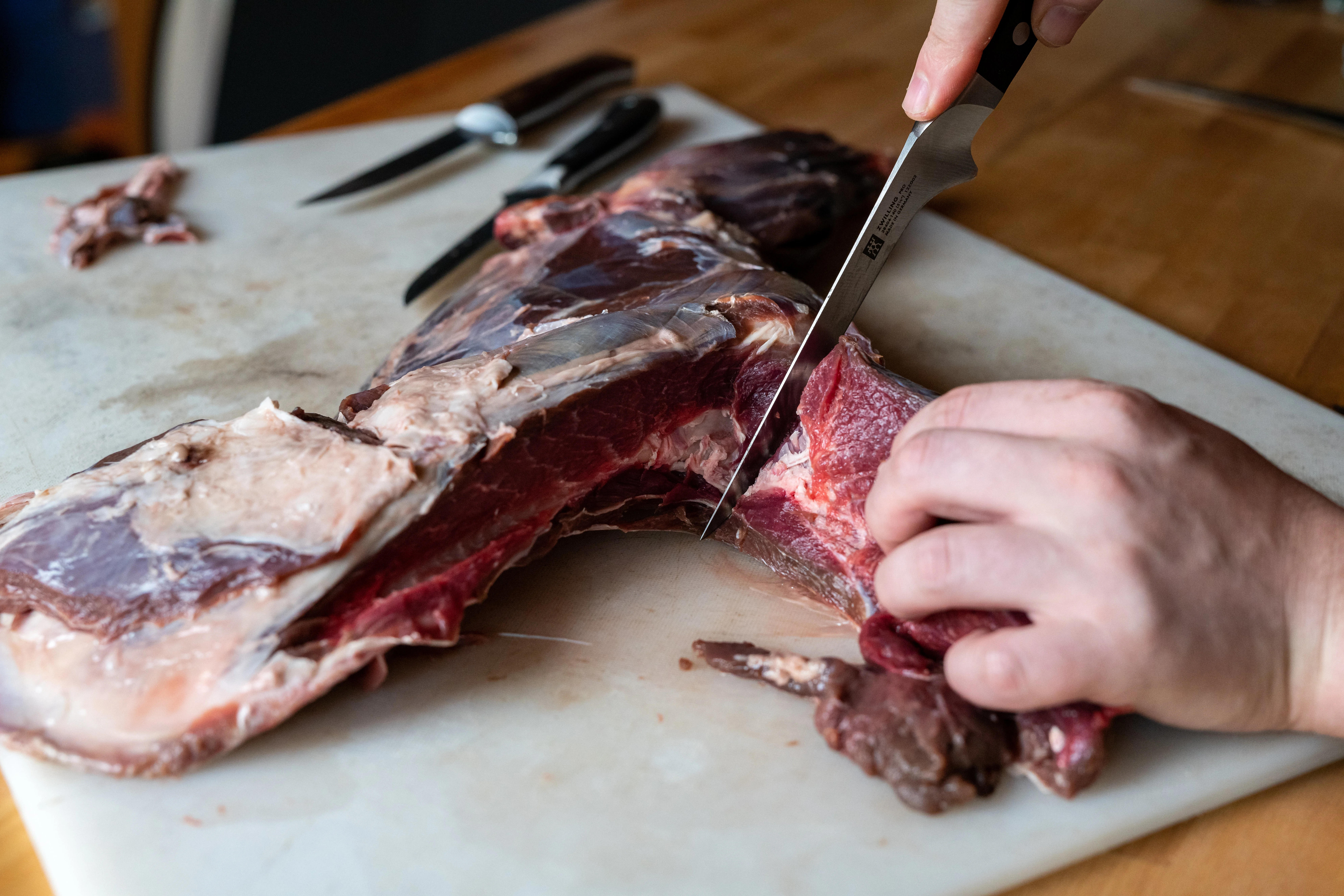
The full-tang blade blank transitions into a triple-riveted ABS polymer handle for added durability. The handle itself is very smooth and lacks finger purchase, but it still has plenty of grip. The whole knife is slick and seamless and there are not a lot of grooves or edges to collect gunk, making it easy to keep clean. While it does not have finger indexing, the curved bolster keeps fingers safe from slipping forward. The bolster is also sharpened along its front edge allowing for smooth forward cuts. The knife itself is well balanced and relatively comfortable. With heavy use, gripping the somewhat square handle can cause friction and knife blisters but it’s by no means a deal-breaker or unique to this knife.
At around $120, the Zwilling Pro is not a cheap knife. But if you subscribe to the by-once-cry-once school of thought, it’s a worthwhile investment with a ton of utility. You get extremely high-quality German blade technology in a sleek package that will withstand the test of time and cover bluegills, moose, and everything in between.
Best for the Money: Wusthof Classic Ikon 5″ Boning Knife
Key Features
Forged steel
German craftsmanship
Modern design
Pros
Balance
High quality
Very sharp
Cons
Handle profile
Price
The Wusthof Classic Ikon is the best boning knife for the money. Wusthof is another German knife maker with a reputation for durable, sharp, and dependable cutlery. Wusthof is a well-known name in home kitchens, but it’s widely used among chefs and culinary professionals, as well. Wusthof knives bridge the gap between a utilitarian workhorse knife and a high-end custom blade. Their knives sport incredibly high quality at a price that, while by no means cheap, is affordable for a long-term, worthwhile investment. Although Wusthof is a large company, there’s still a significant amount of craftsmanship that goes into every knife.
The classic Ikon features a modern, sleek design and single-piece forged steel construction. The first thing you notice about the Ikon is how well-balanced it is. It’s a very back-heavy knife, with most of the weight distributed towards the rear of the handle. Because of this, it feels very light in the hand. With the German stainless steel blade, you get that characteristically hard metal, making the Ikon easy to hone but a chore to sharpen from dull. But once sharpened, it will remain sharp for significantly longer than lesser-quality, softer metal blades. Like all Wusthof knives, it comes razor-sharp from the factory. It has a good amount of flexibility to it, but still has plenty of backbone when you need it to pry between sockets or cut through soft bone and cartilage. It has just enough spring to bend with the natural contours of the animal and work around into the nooks and crannies with the tip.
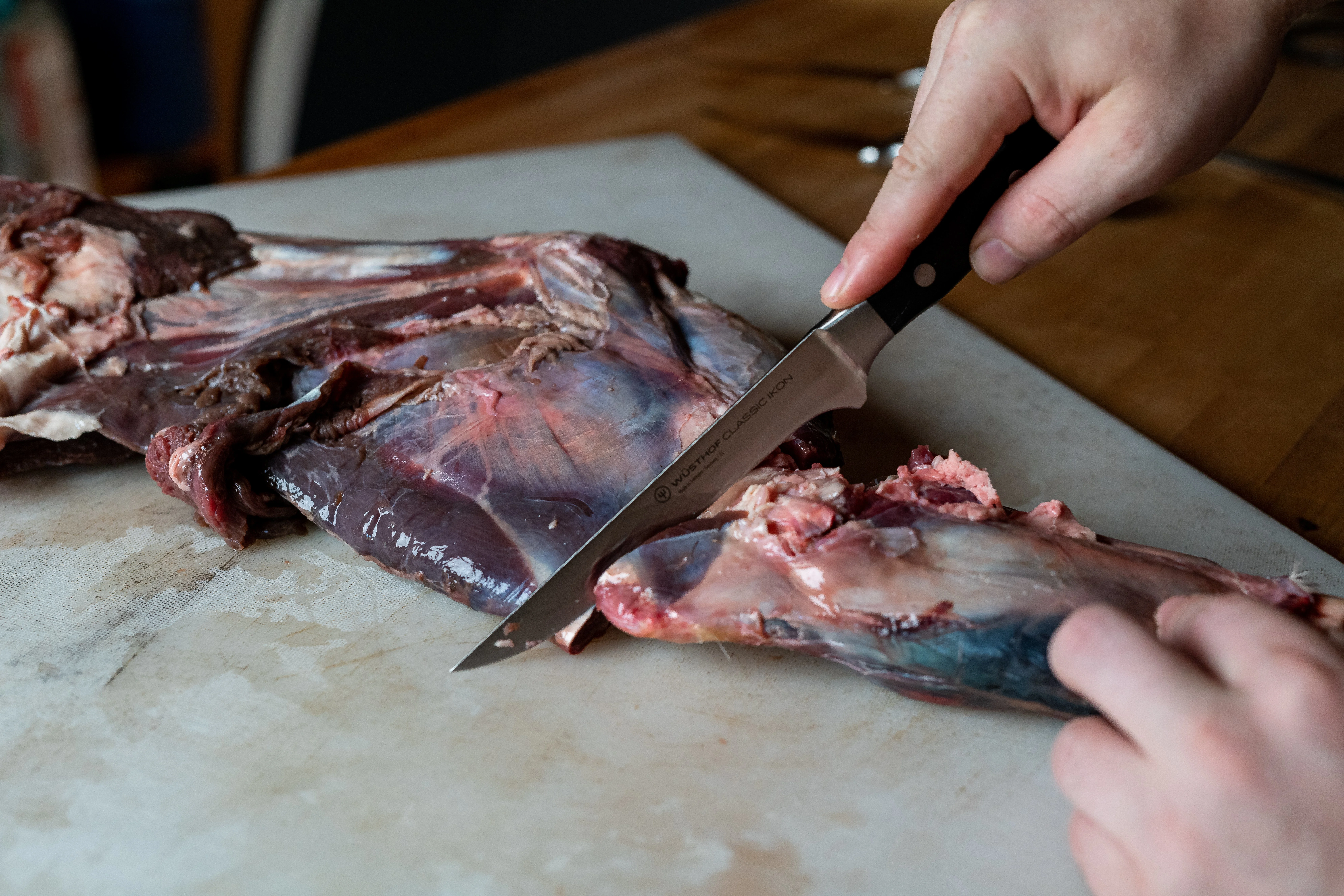
The handle is made with a synthetic composite and is triple riveted to the full tang blank. The handle does not feature any type of finger indexing or texturing for added grip. The tapered shape of the handle also makes your hand feel like it’s being pushed forward towards the front of the knife. This is fine for more delicate work but does not allow for the best grip. The small, thin bolster is not terribly protective or comfortable, but it’s adequate to protect your hand. Because of the knife’s smooth, seamless design, there are no edges or areas for fat hair, blood or other gunk to get caught up so it is both sanitary and easy to clean. The smooth round handle also doesn’t have any sharp square edges to wear on your hand and cause hot spots or blisters.
At around $160, the Wusthof Classic Ikon is not for the casual home butcher. The price may or may not be worth it to you depending on your circumstances. But if you’re looking for a long-term investment that’s a significant step above the stamped soft metal budget boning knives, the Classic Ikon is an excellent choice. I have personally used Wusthof knives for years at home and in professional kitchens and they have always been dependable. You might go through several boning knives in the time it takes your Wusthof to show any signs of wear.
Best for Processing Deer: Opinel Les Forges 1890 5” Boning Knife
Key Features
Forged X50CrMoV15 steel
Full tang
Treated European Beech Wood handle
Pros
High-quality materials
Craftsmanship
Attractive and stylish
Cons
Very stiff
Price
The Opinel Forged 1890 5″ Boning Knife is the best boning knife for hunters. Opinel is best known for its wooden-handled folding knives (which make great pocket knives) with a characteristic Viroblock locking ring. But Opinel has been cranking out a variety of knives since 1890. The French company produces high-quality knives that not only work extremely well but look good doing so. Their 1890 5” boning knife features a full tang X50CrMoV15 Stainless Steel forged blade that flows nicely into an attractive treated European beech wood handle. The blade is quite stiff and a little short compared to some other boning knives making it not the best choice for long-reaching or delicate work where your blade needs to be able to bend. It is, however, quite good for leveraging in between joints, breaking down game birds, and working with large muscle groups. It performs better with short, precise cuts around bone than with long strokes, such as those to remove silverskin.
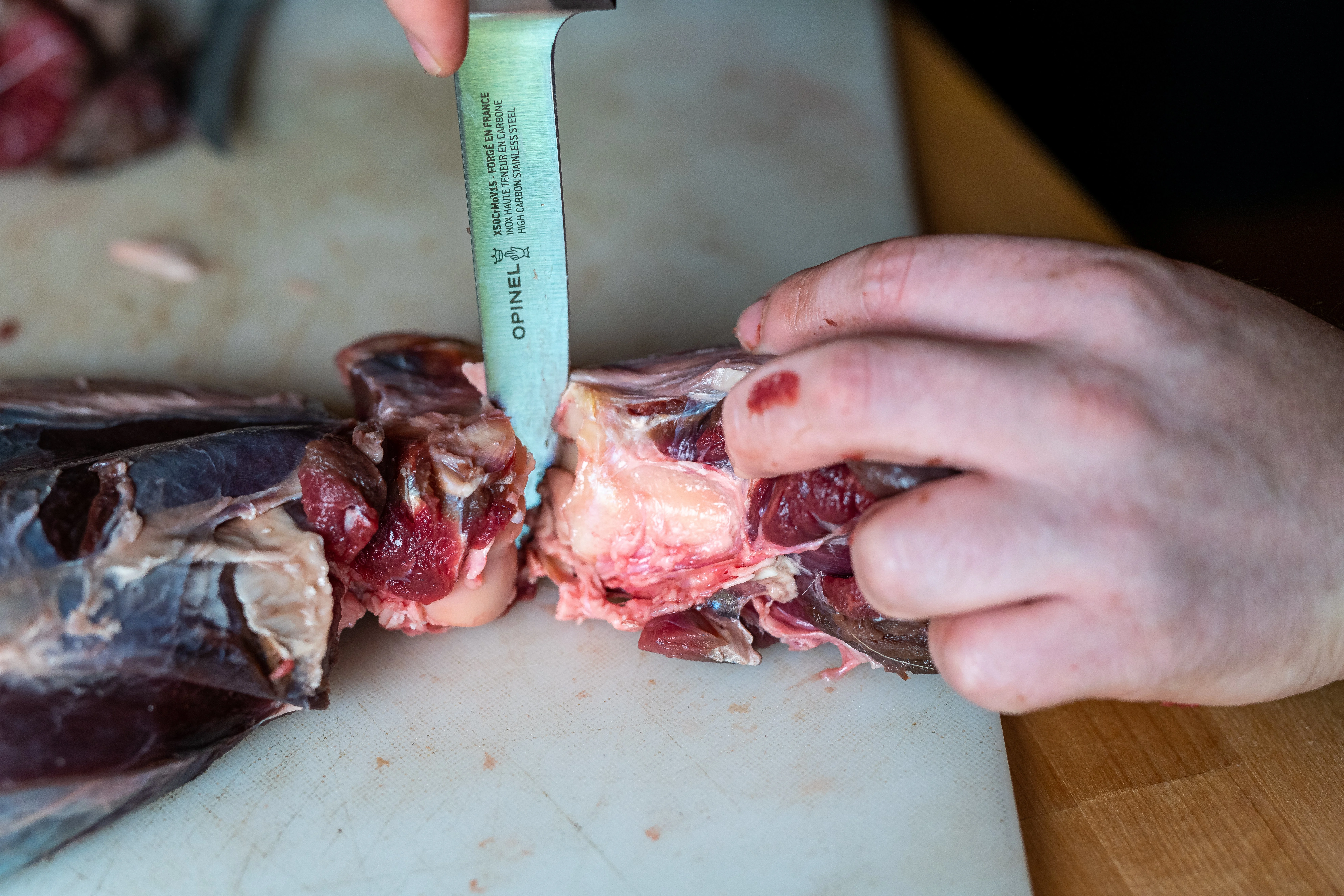
The blade is made of a single piece of hot forged TX50CrMoV15, which is a German stainless steel—favored for hardness and corrosion resistance—generally used in high-end chefs’ knives. The blade comes extremely sharp from the factory and holds an edge through quite a lot of abuse. A few strokes on a honing steel are usually enough to get the knife back in working order, but if you really dull the blade, the sharpening process will take a bit longer due to the very hard, high-quality metal.
The blade transitions seamlessly into a heavy bolster to protect your hands from slipping forward. The ergonomic beech wood handle is comfortable in the hand, and while it is neither textured nor grooved, it still provides a decent grip. Unlike many commercial knives with industrial designs and synthetic handles, the Opinel has a classic look and crafted feel. It has a certain bespoke quality to it that gives it character beyond the Spartan utility of a boning knife. This attractive knife would make an excellent gift for the hunters and home butchers in your life. At around $170, the Opinel is not much of a bargain. But if you appreciate quality, craftsmanship, and style you can’t go wrong with this good-looking and powerful tool.
How We Tested Boning Knives
For this roundup, we tested each knife on a couple of whitetail deer quarters. We used the knives to remove major muscle groups, cut the meat off the bone, cut through cartilage and sinew, and remove silverskin. We also used the knives to cut around joints and to pry open sockets. We spent a considerable amount of time cutting with each knife, as well as testing how well each blade retained its edge after use. We did this by cutting through paper after using each knife on the deer quarters. We also used a honing steel and jewel stick to touch up each knife after testing to see how sharp the blade was after heavy use, as well as how quickly it could be brought back to a razor edge. In addition to the hands-on testing, I drew on my extensive experience as a culinary and outdoor industry professional to talk about each knife and help you make the most informed decision possible.
What To Consider When Buying a Boning Knife
Blade Material
When it comes to knives, you can generally think about blade materials as either hard or soft. Hard metals are higher quality, more durable, hold an edge longer, and can be made sharper than soft metals, but they are also generally more expensive and harder to sharpen. Softer metals are typically cheaper, more flexible (but more brittle), and easier to sharpen, but they can lack edge retention and durability. The best boning knives are somewhere in the middle, offering high-quality steel that is still plenty flexible—able to take and hold an edge quickly. There’s no right answer, and there are strong arguments to be made for both. Considering the constant blade-to-bone contact and abuse a boning knife blade takes, the cheaper, easy sharpening steel is often the preferred choice. Many chefs and professional butchers prefer this type of boning knife. It may dull quicker than an expensive high-end blade, but it can be quickly honed and returned to work.
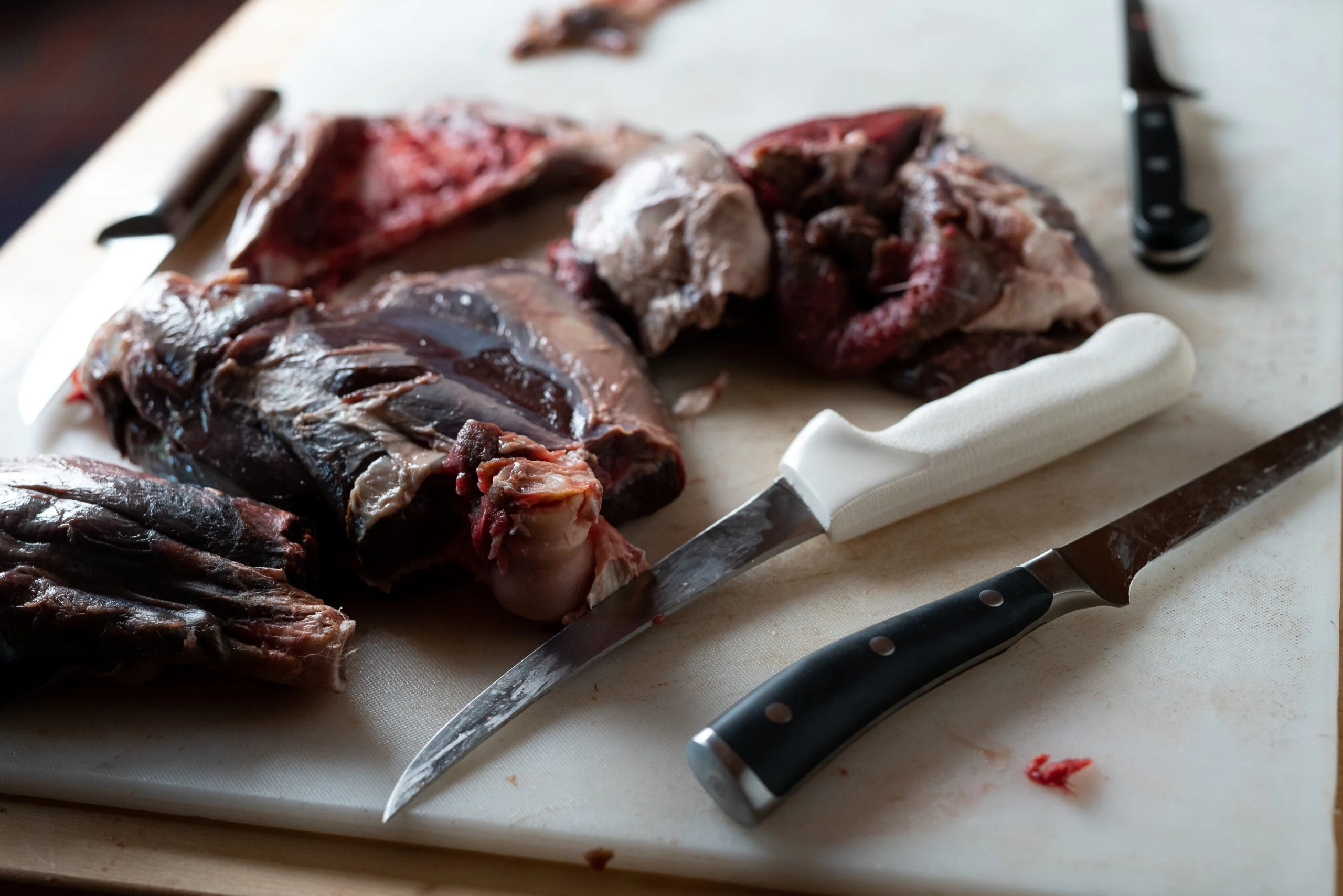
Grip
Grip is extremely important when it comes to butchering and processing tools. Working with meat and fish is a slippery business, and you need to be able to hold onto your knife regardless of how bloody or wet your hands or work surface might be. While there are many handle materials used for boning knives, laminated wood and synthetic materials are among the most popular. Rubber and soft plastic handles tend to provide the best grip. Wood, metal, and hard plastic handles, while easier to clean, are significantly harder to hold onto.
Flex
While not usually as dramatic as fillet knives, most boning knives have some degree of flex. This allows the blade to bend with the natural seams and contours of the animal so you can cut in between joints, under silverskin, and closer to the bone to minimize wasted meat.
Price
You don’t need to spend a fortune to get your hands on one of the best boning knives. On average, a really good boning knife can be found for about $30 to $50. In this price range, you’re going to find mostly commercial-grade knives that may not be the highest quality steel and materials, but are easy to sharpen and you won’t feel bad about abusing them. You can also spend significantly more for a premium knife with better materials, build quality, and a sharper blade, but there are drawbacks as well. With an expensive knife, you may also subconsciously try to protect your investment, becoming hesitant to pry on or cut against bones, bust through cartilage, and perform other rough tasks that a boning knife is designed for.
FAQs
Q: What makes a good boning knife?
A good boning knife has to be extremely sharp, durable, provide excellent grip, and have some degree of flexibility. It’s also important that the knife has good edge retention so it can be easily honed and get back to work quickly.
Q: How much does a boning knife cost?
Boning knives range anywhere from roughly $20 on the low end to hundreds of dollars on the high end. You can find a rock-solid boning knife for around $30 to $50, but a high-quality knife that will last a lifetime will probably run you closer to $150.
Q: What is the best boning knife?
The best boning knife largely depends on the individual buying the knife. Those on a budget or who work on a high volume of animals may be better served with a less expensive commercial option. Others may prefer to splurge on a more expensive model with higher quality steel and finer craftsmanship. Likewise, different people work on different types of animals and certain qualities of a knife may make it superior to others for the job. The “best” boning knife is the one that you feel good using.
Final Thoughts
The good news is that it’s hard to buy a bad boning knife. But with so many options on the market, it can be difficult to find the one that’s right for you. Overall, the Dexter S131-6 (and frankly the entire Dexter boning knife line) is simply too good to beat. It gives you excellent blade quality, durability, grip, cleanliness, and ease of sharpening at a cost that anyone can afford. Whether you butcher one animal a year, or it’s your full-time job, you can’t go wrong with a Dexter. Equally impressive are some of the higher-end knives from long-standing and reputable companies such as Wusthoff, Zwilling, Opinel, and others. For a bit more money these knives provide a lifetime of use and are trusted by professional cooks and butchers everywhere. In the end, there’s no one-size-fits-all best boning knife for everyone. But you can be certain that any of the knives on this list are excellent choices for your home or commercial butchering needs.
Why Trust Us
For more than 125 years, Field & Stream has been providing readers with honest and authentic coverage of outdoor gear. Our writers and editors eat, sleep, and breathe the outdoors, and that passion comes through in our product reviews. You can count on F&S to keep you up to date on the best new gear. And when we write about a product—whether it’s a bass lure or a backpack—we cover the good and the bad, so you know exactly what to expect before you decide to make a purchase.

